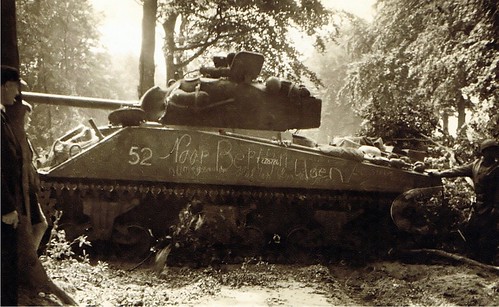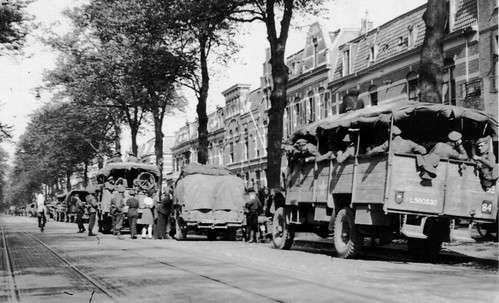The British XXX Corps
30th Corps of the British second army has to advance along the corridor, which the paratroopers will open for them. The corps had gathered along the Belgian - Dutch border just prior to the beginning of the operation.
According to Montgomery's plan, the 30th corps will need 48 hours to advance through Valkenswaard, Eindhoven, Son, Veghel, Grave, Nijmegen, Elst and finally Arnhem.
When 30th Corps reaches Arnhem it will be able to swing to the east and advance into the Ruhr, the industrial hearth of Germany.
On 17 September the German army is no longer on the run. Many Germans that had escaped the Allied attempt to surround them in France had crossed Belgium and had gathered in the southern part of Holland.
The German general Kurt Student (A veteran who had jumped into Holland and Crete) was now forming the 5th German Para Armee. Several old units where disband and new units where formed from the remnants of the old.
General Student leads the German defense and when 30th Corps advances it has to fight for every kilometer from their jump off point in Belgium up to Valkenswaard, the first city on their route. The city is captured on the evening of the first day. According to Montgomery's schedule 30th Corps should have passed Eindhoven by that time.
The Irish Guards under the command of colonel Vandeleur spearhead the advance of 30th Corps. On the second day the cheering people of Eindhoven who celebrate the arrival of their liberators slow their advance down. The Irish Guards link up with the 101st around noon, eighteen hours behind schedule.
The bridge at Son had been blown before the 506th Regiment of the 101st Airborne Division was able to capture it on the 17th.
The Airborne engineers had to wait for the British arrival before they could replace the bridge with a bailey bridge.
British and American engineers work throughout the night from 18 to 19 September and around eight o'clock in the morning the first tanks cross the bridge.
One hour and fifteen minutes later the spearhead of the British army arrives at Grave bridge and link up with the 82nd Airborne Division. Grave bridge had been captured by the 504th on the 17th so the British army can advance towards Nijmegen.
The fact that the spearhead of the advance has reached Grave does not mean that the rest of the British second army can now safely follow them. In the next days the corridor in the area of the 101st Airborne division will be cut by German tanks and infantry at several places along the route. The Americans and the British need all their energy to keep the road open which will later be known as Hells Highway.
 153rd Field Regiment Royal Artillery, crossing the Waal Bridge, Nijmegen 20th September 1944 Photo courtesy by orangetim.
153rd Field Regiment Royal Artillery, crossing the Waal Bridge, Nijmegen 20th September 1944 Photo courtesy by orangetim.
On the 20th the 504th Regiment crosses the Waal in small rafts under the command of major Julian Cook. They attack the elements of the 10th Panzer division who hold the British advance at the Nijmegen bridge. The Germans have five hundred men at the bridge but when the Americans have crossed the river and the British tanks advance on them from the south they have to give up the bridge. The tanks cross the bridge and are then fourteen kilometers away from the bride at Arnhem.
The island (the part of Holland between the River Waal and Rhine) is a part, which is difficult to enter with tanks. The fields are to soft for tanks and the roads are on dikes that split the fields which make the tanks very easy targets since there is no room to manoeuvre and they can be spotted from miles.
 M4A4 Sherman FireFly, 1st (Armored) Bn, Coldstream Guards, The Guards Armored Division, The Netherlands, 21st September 1944 Photo courtesy by orangetim.
M4A4 Sherman FireFly, 1st (Armored) Bn, Coldstream Guards, The Guards Armored Division, The Netherlands, 21st September 1944 Photo courtesy by orangetim.
On the 21st the Irish Guards advance towards Arnhem but they are halted at Elst. At the same time the British forces at the bridge in Arnhem have to stop their defense of the bridge. Frost surrenders with is men. At that time of the surrender his small force is almost completely without ammunition and food.
The Wessex division reached the Polish at Driel on the next day. On the 25th the British at Oosterbeek received the order to retreat across the Rhine.
1.700 Airborne soldiers and 420 glider pilots where pulled back across the Rhine in the night of the 25th. Most of them cross in the boats but some of the men swim across. Three hundred men remained on the north bank when the retreat was halted.
The British had flown into Arnhem with ten thousand men and after nine days of combat they came out with little more than two thousand.
The ground forces lost 5.334 men during the Market Garden operation. The American 82nd and 101st Airborne divisions loose 3.974 men and the Polish lose 378 men. The allied air forces loose 718 men during the operation and the German losses are estimated at 10.000 men.
 The Guards armored division in Nijmegen 20th September 1944, Photo Courtesy by orangetim.
The Guards armored division in Nijmegen 20th September 1944, Photo Courtesy by orangetim.
Photos of the advance of the Guards Armoured Division through Aalst on September 18 1944.
Booking.com
© All rights reserved
Contact




